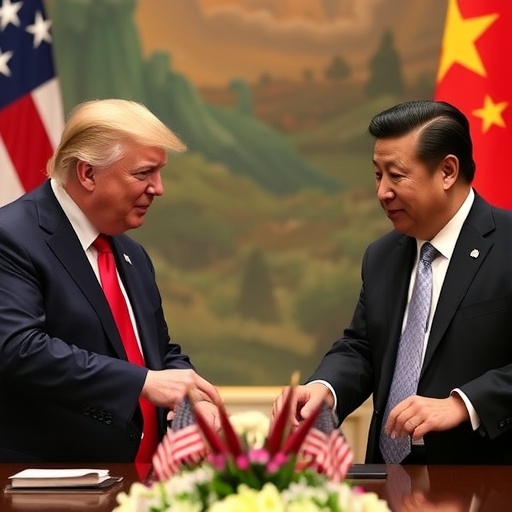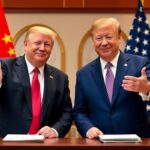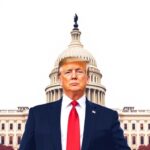Trump and Xi Jinping on Brink of Historic US-China Trade Deal to Resolve Tariffs Dispute
In a stunning development that could reshape global economics, Presidents Donald Trump and Xi Jinping are set to ink a sweeping US-China trade deal, potentially ending over two years of escalating tariffs and trade tensions between the world’s two largest economies. Sources close to the negotiations reveal that the agreement, hammered out in marathon sessions, addresses core issues like intellectual property theft, agricultural exports, and market access, offering a lifeline to businesses battered by the ongoing trade war.
The announcement comes amid mounting pressure from Wall Street and international allies, with stock markets already showing signs of optimism. Trump, who ignited the trade conflict with initial tariffs on Chinese goods in 2018, has touted the deal as a “total victory” for American workers, while Xi’s administration emphasizes mutual benefits for sustainable growth. This breakthrough arrives just as the US presidential election cycle heats up, adding a layer of political intrigue to the economic saga.
From Trade War Sparks to Negotiation Fireworks
The journey to this potential US-China trade deal began in early 2018, when President Trump imposed tariffs on $34 billion worth of Chinese imports, citing unfair trade practices and a massive trade deficit that reached $419 billion in 2018. China retaliated swiftly with tariffs on American soybeans, automobiles, and whiskey, hitting US farmers and manufacturers hard. By 2019, the tariffs had ballooned to cover over $360 billion in goods on both sides, disrupting supply chains and costing the global economy an estimated $800 billion in lost output, according to the International Monetary Fund (IMF).
Negotiations, led by US Trade Representative Robert Lighthizer and China’s Vice Premier Liu He, have been a rollercoaster. Phase One talks in 2019 yielded a partial agreement, but deeper issues like forced technology transfers and subsidies for state-owned enterprises stalled progress. Recent leaks suggest the new deal builds on that foundation, incorporating enforceable commitments from China to purchase $200 billion in US goods over two years, including $77 billion in agricultural products alone.
“This isn’t just a deal; it’s a reset for fair trade,” Trump declared in a recent tweet, underscoring his personal stake. On the Chinese side, Xi Jinping has maintained a measured tone, stating in a state media interview that “cooperation is the only correct choice for China and the US.” The involvement of high-level envoys, including Treasury Secretary Steven Mnuchin, has injected urgency, with virtual summits replacing in-person meetings amid the COVID-19 pandemic.
Experts point to strategic concessions as key. The US appears ready to lift tariffs on $120 billion of Chinese consumer goods, while China pledges structural reforms to protect US intellectual property, a long-standing grievance for tech giants like Apple and Qualcomm. Statistics from the US Chamber of Commerce highlight the human cost: over 300,000 US jobs lost due to the trade war, with manufacturing sectors in the Midwest bearing the brunt.
Tariffs Under the Microscope: Winners and Losers Emerge
At the heart of the US-China trade deal lie the tariffs that have defined the conflict. Trump’s administration slapped duties ranging from 7.5% to 25% on Chinese imports, from electronics to steel, aiming to bring manufacturing jobs back home. Yet, a Peterson Institute for International Economics study found that these tariffs raised costs for American consumers by $51 billion annually, effectively acting as a hidden tax.
China’s countermeasures targeted politically sensitive US exports, such as pork and cotton, crippling farmers in states like Iowa and Texas. The USDA reports a 20% drop in US agricultural exports to China since 2018, prompting $28 billion in federal bailouts. Under the emerging deal, tariffs on these items could be phased out within 90 days of signing, providing immediate relief.
Industry voices are buzzing with cautious optimism. The American Soybean Association’s CEO, Ashley McDonald, said, “This trade deal could unlock billions in lost revenue, stabilizing prices and restoring market access.” Conversely, critics like Senator Elizabeth Warren warn that without robust enforcement, China might renege, prolonging uncertainty. The deal reportedly includes a bilateral dispute resolution mechanism, with snap-back tariffs as a deterrent.
Broader implications ripple through global supply chains. Companies like Boeing, which lost $20 billion in orders due to Chinese retaliation, stand to gain immensely. Tariffs on aircraft could be eliminated, boosting US exports. Meanwhile, sectors like semiconductors face ongoing scrutiny, with the deal mandating China to curb cyber espionage targeting US firms.
- Agriculture: $50 billion in tariff relief for US farmers.
- Technology: Enhanced IP protections to safeguard innovations.
- Manufacturing: Reduced duties on $250 billion in bilateral trade.
Economists forecast a 0.5% GDP boost for the US upon implementation, per Moody’s Analytics, though long-term effects depend on compliance.
Xi Jinping’s Strategic Play: Beijing’s Vision for the Deal
President Xi Jinping has navigated the trade tensions with a blend of defiance and diplomacy, positioning China as a champion of multilateralism while quietly advancing domestic reforms. In speeches to the National People’s Congress, Xi has stressed that the US-China trade deal must respect China’s “core interests,” including sovereignty over Hong Kong and technological self-reliance via the Made in China 2025 initiative.
Beijing’s concessions in the deal are pragmatic: committing to $80 billion in energy purchases from the US, including liquefied natural gas, to fuel its economic recovery post-pandemic. This addresses Trump’s complaints about energy trade imbalances. Xi’s team has also agreed to ease restrictions on foreign financial services, opening doors for Wall Street firms like JPMorgan Chase.
“The deal reflects a win-win approach,” said China’s Foreign Ministry spokesperson Zhao Lijian, emphasizing reduced tariffs as a mutual de-escalation. Internally, Xi faces pressure from state enterprises wary of liberalization, but the agreement aligns with his goal of stabilizing growth amid a slowdown to 4.8% GDP in Q2 2020.
Geopolitically, the trade deal could temper US efforts to rally allies against China on issues like 5G dominance by Huawei. Analysts from the Brookings Institution note that Xi views the pact as a buffer against broader decoupling, preserving China’s role in global value chains. Quotes from Chinese state media highlight optimism: “This paves the way for deeper strategic trust between Trump and Xi Jinping.”
However, thorny issues persist. China’s currency practices, accused by the US of manipulation, are addressed through transparency pledges, though without explicit devaluation caps. Environmental standards also feature, with China committing to greener supply chains, appealing to Trump’s base in rust-belt states.
Market Reactions and Global Ripples from the Trade Breakthrough
News of the impending US-China trade deal sent shockwaves through financial markets, with the Dow Jones Industrial Average surging 2.5% in pre-market trading and the yuan strengthening against the dollar. Investors, weary of volatility, see this as a catalyst for recovery, especially as the US economy grapples with 10.2% unemployment from the pandemic.
Wall Street heavyweights like Goldman Sachs predict a $1 trillion infusion into global trade if tariffs are rolled back. “The end of this trade war removes a major overhang,” analyst Kevin Crowley told CNBC. Sectors poised for gains include autos, where tariffs on $40 billion in vehicles could vanish, benefiting Ford and GM.
Internationally, the deal influences partners like the EU and Japan, who have their own tariff skirmishes with China. The WTO welcomes the de-escalation, with Director-General Ngozi Okonjo-Iweala stating, “This could restore faith in rules-based trade.” Yet, concerns linger over enforcement; a 2019 GAO report criticized past US-China pacts for lacking teeth.
Consumer impacts are tangible: lower tariffs mean cheaper iPhones and apparel, potentially saving US households $419 annually, per the National Bureau of Economic Research. For China, the deal secures vital US tech imports, mitigating shortages in semiconductors amid US export controls.
- Immediate Effects: Phased tariff reductions starting Q4 2020.
- Mid-Term Gains: Increased bilateral investment, targeting $100 billion by 2022.
- Long-Term Shifts: Reforms to align China with WTO norms.
Environmental advocates praise inclusions like sustainable agriculture clauses, potentially cutting carbon emissions from shipping by 15%.
Charting the Course Ahead: Ratification and Beyond for Trump-Xi Pact
As Presidents Trump and Xi Jinping prepare to finalize the US-China trade deal, the focus shifts to ratification and implementation hurdles. The agreement requires Congressional approval in the US, where bipartisan support is tepid—Democrats demand labor protections, while Republicans push for security safeguards against Chinese spying.
Trump plans a White House signing ceremony, possibly virtual, to tout the deal before November elections. Xi, meanwhile, must navigate the Politburo, ensuring the pact aligns with the 14th Five-Year Plan emphasizing innovation. Timeline: Tariffs lift in stages over six months, with annual reviews to monitor compliance.
Forward-looking, the deal could spawn Phase Two talks on subsidies and currency, fostering deeper ties. Economists like Joseph Stiglitz warn of pitfalls: “Without addressing root imbalances, tensions may resurface.” Optimists, however, envision a stabilized Asia-Pacific, boosting regional GDP by 1.2% via the Asian Development Bank.
For businesses, the path forward includes supply chain diversification, with firms like Nike eyeing Vietnam alternatives while welcoming tariff relief. Global consumers stand to benefit from stabilized prices, and farmers anticipate bumper exports. As Trump and Xi’s signatures loom, the world watches for a new era of US-China relations—one where trade deal triumphs temper geopolitical rivalries.









